The Slide Show
This is an archive post that will be updated as we learn and discuss more.
Dr. Arnie Baker's powerpoint presentation shows a few of the defenses that will be used by Landis, but not all of them. It focuses on the ones that are easiest to explain. Landis has already said he's not putting all the defense cards on the table, so if this is unconvincing, don't assume that is all there is.
[more]
[continuation]
The first we heard about of the Slide Show was a USA Today report late on 7-October. A copy of the PDF is mirrored on archive.org if the link to the original on FloydLandis.com is slow or broken.
The footer "ABC slide show" refers to Arnie Baker Cycling, not the ABC network. Dr. Baker prepared the set, and will be presenting it at the San Diego Trek store on October 18th.
Where the slides reference "USADA number", these are pages in the USADA provided Laboratory Documentation Packages. These are here, and each description below includes direct links to the references pages.
Individual page links for the slides are here.
Click on the pictures to see a larger image, or the slide title to see the page in original PDF format.
First Slide
The first slide asks whether Landis was positive.
comment: This being the defense presentation, we can guess what the answer will be.
Slide 2
Says there are four main ways the testing produced an erroneous result. Sample error, contamination, unreliable tests, failure to meet positive criteria.
comment: "Doesn't make sense" won't come into the factual resolution, as the strict liability standard for doping doesn't care whether it makes sense, only that the wrong things were present in his body.
Slide two also mentions there are defense arguments beyond those in the presentation, some more technical than those shown, so we should not take this as the complete defense.
Slide 3
Explains some sample labelling problems that are being offered to show general lapses in the lab proceses. They aren't claiming the samples aren't his, but that errors are made in the simplest parts of the paperwork.
comment: This is a supporting argument, but doesn't relate to critical facts. It is asking the viewer to imply that because some small things were done incorrectly, there is a liklihood that big things are done wrong as well.
This whole line of reasoning doesn't affect factual determination, but it does affect the general credibility of the lab. That Landis is not using this as a critical point indicates he does not want to be seen as quibbling about minor technicalities.
Slide 4 
cites WADA standard for how corrections should be made.
references: WADA TD2003LCOC, WADA ISL
Slide 5
shows that on the A Sample result page, this wasn't followed for the sample number! It was done with whiteout and an overwrite. Notes, this isn't being offered to say the results were for the wrong sample, just that the lab doesn't do things correctly.
Reference: USADA_009
Slide 6 
repeats the point, showing either an error or an ambiguity with a transportation record. Again, not show to say it didn't end up being his sample, but that record keeping is lax.
Reference: USADA_024
Slide 7 
shows another sample number error, on a result summary sheet, previously known to TBV as one of the Ferret pages. The slide also notes that Landis should not have received any data about other samples. This is a lab data handling failure.
comment: While the lab was being complete in the documentation, it should probably have redacted all data about other samples.
This should have no bearing on the factual decision about the case.
Reference: USADA_008
Slide 8 
begins a section on contamination. It cites the WADA protocol that this is something to be concerned about.
reference: WADA TD2004EAAS
Slide 9 
shows the WADA criteria for determining that a sample has been contaminated, and should not be used for measurements.
reference: WADA TD2004EAAS specifically, here.
Slide 10 
argues the Landis A sample exceeded that standard. It should have been seen as having been contaminated, and testing stopped, period. comment: It is not clear where the justification for the 5% rule in the WADA protocol comes from.
comment: It is not clear where the justification for the 5% rule in the WADA protocol comes from.
This is a solid argument that would need to be refuted by the USADA side.The ADA side may try to wave hands and say it doesn't matter in this case. It would help for Landis to have some science to show how contamination affects the results of the tests.
References: USADA_283, USADA_288
Slide 11 
shows the same values on the B sample, .44 and 5.7, indicating the same level of contamination or degradation as present in the A sample.
comment: No hiding for the ADA side, same problem on both samples.
References: USADA_283, USADA_288
Slide 12 
moves into the general unreliability of the testing done by the lab. It shows that the T/E measurements have large variances of 30% and 20% that are admitted in the lab documentation.
Reference: USADA_101
Slide 13
shows a large variation in the same test on the same sample further emphasizing lack of repeatability.
comment: These may be comparing screening tests with more accurate confirmation tests. The screening tests are known to be inaccurate, which is why the confirming tests are done. This kind of inconsistency may not seem like a problem to technical reviewers.
references: USADA_092, USADA_0212
Provides a dummy's view of the errors observed.
Comment: I'm not fond of bar charts that use pictures that have different implied 3d volumes than the bar (see Tufte's "chartjunk"), but this isn't that bad if the underlying point is true.
references: USADA_092, USADA_0212
Slide 15
Shows the report pages that provided the data for slide 14.
references: USADA_092, USADA_0212
Slide 16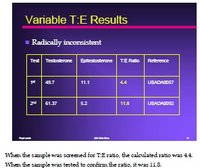
Shows more inconsistently reported values for the T and E measurements.
references: USADA_057, USADA_092
Slide 17
shows the pages where the data for slide 16 was reported.
references: USADA_057, USADA_092
Slide 18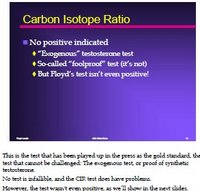
begins discussion of the CIR testing. It does not dispute the results of the test would be correct if it was applied correctly. They are not going to argue against the theory or protocol of the test, but whether the protocol was executed correctly.
comment: CAS has historically rejected attempts to question the science of a test. It makes sense to openly accept the science going in, because you can't get anywhere with a challenge.
Slide 19
Presents an interpretation of the CIR criteria it wants us to believe.
comment: Asking for 3.8 because of .8 tolerance is questionable, because the 3.0 was set with knowledge there were tolerances. However, we don't know what the tolerance was for the 3.0 standard.
Slide 20 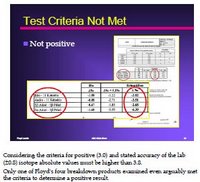
Claims that all four metabolites tested must have CIR > threshold to be found positive, and Landis only had one of the four.
comment: This is where things get controversial. The protocol is ambiguously worded about how many metabolites must be over the threshold to result in a positive test. Landis argues that the ambiguity must be read as "all", while the lab believes "any" is sufficient. There isn't documented precedent, and it is not clear that all labs use the same criteria.
Further, the slide pushes the threshold value to the absolute extreme; the value in the protocol is 3%, and does not include tolerances. The slide adds a maximum error tolerance of 0.8% to get the 3.8%, but that might not be an acceptable interpretation. Certainly if a reported value were way over 3.8% it would be a clear violation. In the middle ground either interpretation could probably be accepted, depending on your prejudice.
Slide 21
shows result report with the four observed values, and says that one of four does not make a positive. The values in the underlying table are
item -0.8% nominal +0.8% e-11k -1.22 -2.02 -2.82 a-11k -2.71 -3.51 -4.31 5bA-5bP -1.85 -2.65 -3.45 5aA-5bP -5.59 -6.39 -7.19
comment: This is the key argument for the case. At face value, two of the four metabolites are positive, but not all four. If we evaluate the tolerances as Baker claims (3.8), we get the conclusion of the slide set, only one of four; if we take them the other way (add 0.8), we get three of four. In the summary of the filing, there is reference to "the best" metabolite, which is the 5bA-5bP. With the nominal reading, this is negative. With a reading against him, it becomes positive. If we accept the "all must be over threshold argument", this positive finding is in trouble by any interpretation of the tolerances.
The summary of the filing also indicates that the one clear positive, presumably the 5aA-5bP, has some obvious error, calling it and possibly the other readings into question.
reference: USADA_352
Slide 22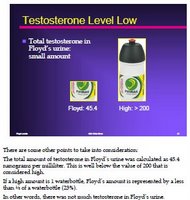
observes that the reported absolute level of Testosterone was not elevated. Values considered "high" are five times those observed.
comment: This validates Landis' early statements that his T was not high, but that his E was low. It also shows every media report that he says "elevated testosterone" has been and is incorrect.
Stephen Colbert take note.
Slide 23
says that the lab tests were not correctly blinded, because the cortisone exemption was clearly in the sample materials.
comment: Depending on how/where this information was visible inside the lab, it may or may not identify whether operators knew the identity of a particular vial.
Reference: USADA_228
Slide 24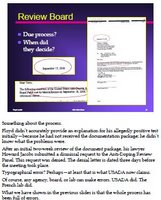
Notes the review board may have had a pre-ordained conclusion because its finding appeared to have been drafted before the tele-conference that was to review the material.
comment: This doesn't affect anything, but it should be embarassing to the ADRB.
Slide 25
summarizes and makes the argument the tests should not have been reported as positive from the lab.
Concluding Comment
The big points are that
If these arguments are accepted, there is (and never was) a true positive, and you can't say he did anything wrong. However, it isnt clear at first glance that the claims are true, which is one of the reasons to get the arguments out and hear what people say.
All the other data presented is supportive of a general sloppiness in the lab, but none is offered to specifically refute the findings of the quantitative tests.
We should remember that these aren't the only arguments that Landis is going to make at his hearing. These are, however, likely to be the easiest ones to understand. Everything else is going to start getting very technical -- important to obtaining a correct result, but much more complicated for Joe Average to follow.
[end]

8 comments:
You comment that the sample number errors are not evidence of important things being done correctly, which is right, but they do irreparably break the link between the sample tested and Landis. We assume that the 4 was meant to be a 5 because the two numbers are side by side, but if you were given the test sheet and alone and were asked what other numbers it could have been its unlikely that you would guess Landis' number. So you cannot be certain that it was a mistake and the sample didn't belong to someone else, or if one digit has been wrongly transcribed which one it was and what it should have been. Its a bit like being caught for speeding. If the license plate recorded is one digit or letter away from your own, there is no longer a valid link between you and the alleged offence and no court would convict. Even if the test was unambiguously positive there is no auditable trail from the sample to Landis.
Second you comment that it is not clear where the 5% rule on contamination comes from. It doesn't have to be clear - it is the rule. Again with the speeding analogy, if the limit is 30 and you were measured doing 28, its no use asking why it was 30 and whether it was an appropriate limit. The fact is you did not exceed it. As soon as you start changing the rules after the event, all semblance of justice goes out the window. You might as well use a ducking stool to judge his guilt in that case
Bless you. I had been longing for the day when someone would mistake me for someone working that side of the fence, and now it has come.
TBV
If my laboratory were to perform this poorly I would be fired, face possible prosecution, and would be sued. The incorrect sample identification completely invalidates this process. The fact that the sample identification did not match the transport log should have immediately raised red flags. This kind of evidence should clear Floyd completely. There is obviously no substantive review process prior to release of results. The quality assurance people/process in this lab should have immediately seen the incorrect sample indentification and invalidated the results. If I were the director of this lab I would be embarrassed and ashamed to have it demonstrated publicly that I have no control over my laboratory processes.
Yeah, but you probably work for a lab where the burden of proof is on you to show that the material your testing has the properties that you proport...my take of the whole WADA testing process is one where the lab produces the result and its up to the athlete to prove them wrong.
WADA's defense of their testing and prosecution seems shaky at best. I think that Landis' biggest foe will be a reaction from WADA to uphold the results or their reputation for testing will be gone. They will fight like dogs to ignore all of Landis' claims. This, in the long run, could serve to submarine their reputation.
On the other hand, should they concede to Landis in this case and place firmer controls and protocols on testing, they they may emerge as a more authentic testing authority.
The use of "white-out" to correct a mistake is huge. As a doctor, if I were to do this, it could be construed as malpractice by showing my intent to hide the truth. Consequently, I do not have "white-out" anywhere in my office. The other lab mistakes are also pretty horrendous. Thanks for the info.
So basically, Floyd's sample (995474) is not listed on the chain-of-custody form documenting transport of the samples from stage 17 to the laboratory.
Just because there is a similarly numbered sample (995476) on the transport form doesn't mean it was Floyd's sample. The person filling out the form could have just as easily have written the number down correctly - which would be indicative of someone tampering with the sample.
Reasonable people can disagree about the handwriting interpretation. A link given in the Tuesday Oct 17 roundup says that the last number
is obviously the correct number:
http://cg.scs.carleton.ca/%7Eluc/landis/
and anyone who wants to hang a defense on them being different is uninating into the wind.
It is not what I'd want to bet my life on.
TBV
Post a Comment